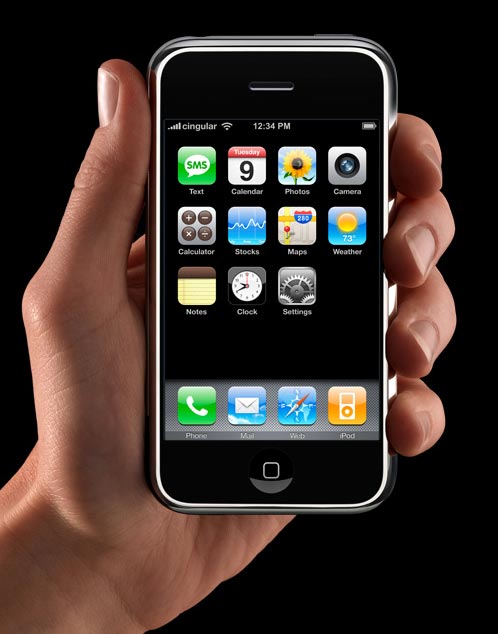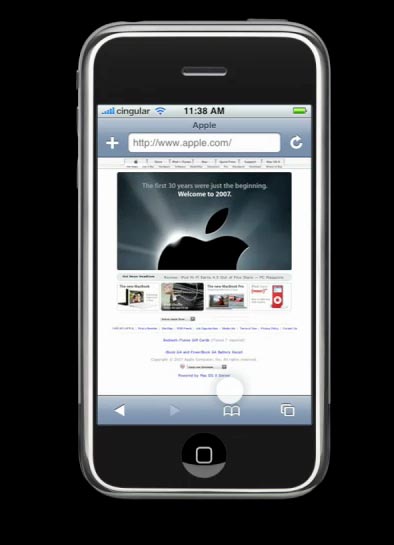CES 2007 - Part II: IPTV on Xbox 360, iPhone and DTX
by Anand Lal Shimpi & Manveer Wasson on January 16, 2007 12:00 AM EST- Posted in
- Trade Shows
Apple’s iPhone
For a while there I’d get just about every Pocket PC that was released with the hope that I’d actually use the new device. Even after the switch to Windows Mobile, the I found myself with a bunch of PDAs that I used only for a short while before the cool-factor wore off and the fact that they weren’t very useful just settled in.
You’d think that over the past decade cellphone makers would be able to perfect these devices that have so ultimately penetrated our lives. In many senses they have, but the one area that has gotten more cluttered than perfected has been in the user interface department. Cell phone UIs are basically an exercise in choosing between the lesser of two evils; of all of the great user interfaces developed in the PC technology era, cell phones are no where near the top of that list.
Smart phones are a bit better, but for the most part they have been victim of poorly scaled down interfaces of their desktop counterparts. What technologies like Intel’s Centrino and Microsoft’s Media Center Edition have taught us is that to truly build a successful product in a particular market, you have to tailor it to that market, you can’t simply use a scaled down version of a product aimed at a different segment and expect it to be perfect.

It’s in the UI that Apple’s iPhone is the most revolutionary, at least upon first glance. Those users who have pointed out that there’s nothing truly new about the iPhone are right; fundamentally most of the features of Apple’s iPhone can be found in other phones, but it’s in how those features that are implemented that set the iPhone apart from its competition.
At first glance the iPhone doesn’t look all that impressive, but in the usage videos at Apple’s site and during the Jobs keynote you really get insight into the strengths of the UI. Its speed, simplicity and organization of things like text messages and voicemails just makes sense, to the point where we wondered why it hadn’t been done before. Obviously there are a lot of unanswered questions about actual usage of the phone and the multi-touch screen, but what we’ve seen initially looks promising. If the iPhone ends up being a failure once you have the device in your hands, at least what we’ve seen from its UI can serve as a blueprint for future smartphone makers of directions to explore.


There will obviously be drawbacks to the iPhone, even the initial demo at Macworld wasn't without flaws. Touch typing will be difficult on a device that provides no tactile feedback, web page rendering speed during Steve's keynote wasn't exactly fast, and neither is Cingular's EDGE network that the device will operate on.

What about cost? Apple has built its business around selling products that command a premium over competitors that fundamentally have a product that has similar functionality. At $499 and $599, the iPhone may be unreasonable for most, but Apple has never built products for the majority of the market. Its pricing won’t lead to failure, but it will not overtake Motorola, Nokia and Sony Ericsson as the leaders in the cell phone market. Don’t expect the iPhone to take significant marketshare away from RIM and its Blackberry devices, although it could significantly hamper RIM’s efforts to bring Blackberry to consumers rather than just enterprise customers.

There are entirely too many enterprise features of Blackberry for the iPhone to offer true competition to it, but for consumer users who RIM hopes to convert with phones like the Blackberry Pearl, the iPhone may be tough competition. In fact, all smartphones in the iPhone’s price range are now at risk of some fierce competition by Apple’s offering. The reason being that a huge population of smartphone customers use their phones for one or more of the features that Apple included in the iPhone: email, web browsing, text messaging and voice. Being able to install your own applications would be nice but it’s not necessarily the type of functionality Apple is targeting with the iPhone; perfection enabled through simplicity is Apple’s game here. It aims to perfect some of the fundamental functions of smartphones and then worry about additional functionality at a later time. Part of the problem with the evolution of cell and smartphone UIs is that so much functionality kept on being added without ever perfecting the interface at any step in the game, leading to devices that can do just about anything at all, but nothing well.

In the world of convergence devices, the iPhone doesn’t actually win Apple any more ground, but it has the potential to truly revolutionize one more gadget we use on a regular basis. If not through the iPhone itself, through the many competitors to it that will undoubtedly rise over the coming years; just look at the effort Microsoft has put into Zune as a result of the iPod. Even if it isn’t met with a tremendous amount of success, whether or not you end up with an iPhone in your pocket the consumer stands to benefit tremendously.










15 Comments
View All Comments
Furen - Tuesday, January 16, 2007 - link
AMD's DTX is not supposed to be as stringent as BTX. BTX required manufacturers to put the DRAM, northbridge and CPU aligned with one another in order to optimize cooling. DTX is more like a smaller ATX (with only two expansion slots and less width) than anything else. Manufacturers should be able to make very different layouts as long as they follow some basic guidelines. One thing that might be an advantage to AMD is that it can work with single-chip chipsets, though I have yet to see a single-chip IGP.Aluvus - Tuesday, January 16, 2007 - link
I am surprised Anand even had to ask why AMD didn't go with nanoBTX, given the known issue of using a processor with integrated memory controller on BTX boards. nanoBTX positions the memory and processor (relative to each other) in the same way that BTX does. This should be obvious.The general failure of BTX as a whole was also a factor, I'm sure.
floffe - Tuesday, January 16, 2007 - link
Plus the royalties to Intel. It's no good business sense pushing a platform that means you and everyone who uses it have to pay money to your worst competitor.Nehemoth - Tuesday, January 16, 2007 - link
Yes the royalties, until i know BTX is not royalties free as the DTX "standard".So DTX is royalties free, is backward compatible so why don't use it?
Missing Ghost - Tuesday, January 16, 2007 - link
The standard is not yet defined.